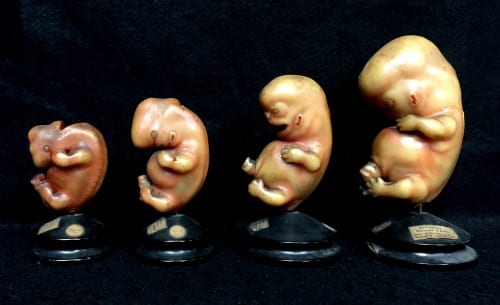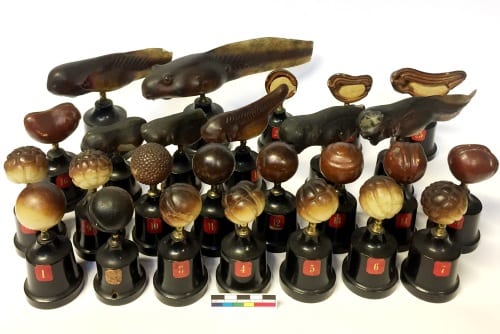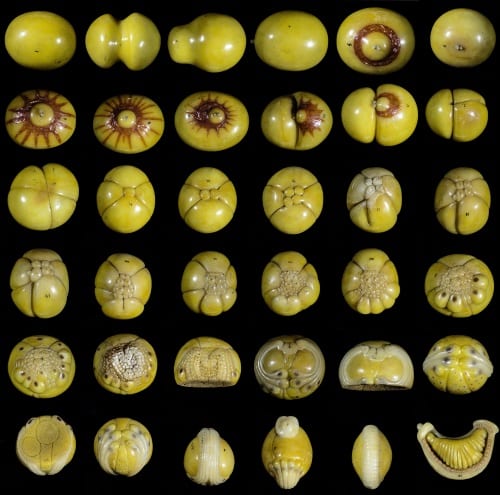Ordinary Animals in the Classroom
By Tannis Davidson, on 6 December 2017
The Grant Museum’s current exhibition – The Museum of Ordinary Animals: The Boring Beasts that Changed the World - explores the mundane creatures in our everyday lives. Here on the blog, we will be delving into some of the stories featured in the exhibition with the UCL researchers who helped put it together.
Guest post by Dr Brendan Clarke (UCL Science and Technology Studies)
Some biological principles are hard to understand from words and images alone, because life exists in three dimensions. This is where museum specimens come in.
However, some features are too small to observe in real life. Alongside microscope slides, wax models of enlarged embryos were widely used to teach biology between 1850 and about 1950. Most of the wax models in the Grant Museum collection represent exotic material – hard to obtain or to handle – like this series of human embryos produced by the Ziegler studio in Germany c1880:

LDUCZ-Z430 Ziegler Studio wax model series showing the development of the external form of human embryos
But two of the Museum’s series of wax models are of ordinary – even boring – animals. They too were made for university teaching. The first is a series of models that shows how tadpoles develop from frogspawn. They were made in the 1850’s also by the Ziegler studio, and were based on a series of engraving made by the German anatomist Alexander Ecker:

Plate XXIII from Ecker’s Icones Physiologicae: Erlaeuterungstafeln zur Physiologie und Entwickelungsgeschichte (1859)
The development of frogs from spawn and tadpoles has long been a favourite topic in biology classrooms, but why would universities go to the trouble of buying models to teach this well-known process?

LDUCZ-W504 Rana temporaria. This series from 1852 shows the development of frog embryos to tadpoles, magnified 16 times, made by the Ziegler Studio in Germany.
I think that the answer is about teaching students to observe in a properly scientific way. As a step-by-step series, we can think of these models as imposing milestones, or highlighting the conceptually important steps, on (what is in life) a continuous process of development. Thus they give us (and the students that used them) a new way of seeing a familiar process in a new – and more scientific – way.
These tadpole models (just) predate widespread interest in evolutionary thought. While they show growth and development, they don’t use development as a vehicle to demonstrate evolutionary ideas.
By contrast, the slightly later series of models of the leech Hemiclepsis marginata are meant to teach us about development so that we can understand evolution. Made in Leipzig at the Institute for Scientific Wax Image Molding around 1880 by Rudolf Weisker, they are based on a series of drawings of leech development by Charles Otis Whitman.
Leeches like these, which are occasionally found in British ponds and streams, might seem peripheral to zoology as a whole (why bother going to the trouble of making – and buying – detailed models of such a mundane creature?). But models such as this series were used by early evolutionists to defend the idea of common ancestry that was a vital part of evolutionary thought. Here, the specific details of leech development don’t matter as much as the comparison with the development of other animals. Whitman’s work on the leech is spun through with such comparisons. Trying to understand how the development of one ordinary animal stood in relation to the development of animals as a whole became a central part of the grand evolutionary project.
The Museum of Ordinary Animals runs until 22nd December. A number of events accompany the exhibition: through discussions, a late opening, a comedy night and offsite events discover how boring beasts shape our relationship with the natural world. Full details are on the exhibition’s website.
Brendan Clarke is Lecturer in History and Philosophy of Medicine at UCL, and contributed to the Museum of Ordinary Animals.
 Close
Close



